高中英语课堂教学设计
- 格式:doc
- 大小:28.50 KB
- 文档页数:7
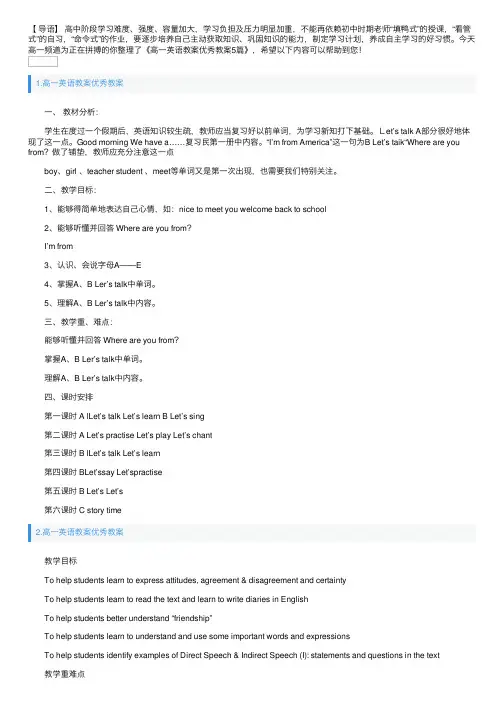
【导语】⾼中阶段学习难度、强度、容量加⼤,学习负担及压⼒明显加重,不能再依赖初中时期⽼师“填鸭式”的授课,“看管式”的⾃习,“命令式”的作业,要逐步培养⾃⼰主动获取知识、巩固知识的能⼒,制定学习计划,养成⾃主学习的好习惯。
今天⾼⼀频道为正在拼搏的你整理了《⾼⼀英语教案优秀教案5篇》,希望以下内容可以帮助到您!1.⾼⼀英语教案优秀教案 ⼀、教材分析: 学⽣在度过⼀个假期后,英语知识较⽣疏,教师应当复习好以前单词,为学习新知打下基础。
Let’s talk A部分很好地体现了这⼀点。
Good morning We have a……复习民第⼀册中内容。
“I’m from America”这⼀句为B Let’s taik“Where are you from?做了铺垫,教师应充分注意这⼀点 boy、girl 、teacher student 、meet等单词⼜是第⼀次出现,也需要我们特别关注。
⼆、教学⽬标: 1、能够得简单地表达⾃⼰⼼情,如:nice to meet you welcome back to school 2、能够听懂并回答 Where are you from? I’m from 3、认识、会说字母A——E 4、掌握A、B Ler’s talk中单词。
5、理解A、B Ler’s talk中内容。
三、教学重、难点: 能够听懂并回答 Where are you from? 掌握A、B Ler’s talk中单词。
理解A、B Ler’s talk中内容。
四、课时安排 第⼀课时 A lLet’s talk Let’s learn B Let’s sing 第⼆课时 A Let’s practise Let’s play Let’s chant 第三课时 B lLet’s talk Let’s learn 第四课时 BLet’ssay Let’spractise 第五课时 B Let’s Let’s 第六课时 C story time2.⾼⼀英语教案优秀教案 教学⽬标 To help students learn to express attitudes, agreement & disagreement and certainty To help students learn to read the text and learn to write diaries in English To help students better understand “friendship” To help students learn to understand and use some important words and expressions To help students identify examples of Direct Speech & Indirect Speech (I): statements and questions in the text 教学重难点 Words upset, ignore, calm, concern, settle, suffer, recover, pack Expressions add up, calm down, have got to, be concerned about, go through, set down, a series of, on purpose, in order to, at dusk, face to facer, no longer/ not …any longer, suffer from, get/ be tired of, pack (sth.) up, get along with, fall in love, join in Patterns “I don’t want to set down a series of facts in a diary as most people do,” said Anne. →Anne said that she didn’t want to set down a series of facts in a diary as most people do. I stayed awake on purpose until half past eleven… …it was the first time in a year and a half that I’d seen the night face to face… 教学⼯具 ppt 教学过程 Hello, everyone. I’m so glad to be your teacher of English. I’d like to make friends with you, to build up a close friendship with you. Today we shall take Unit 1. The topic of this unit is Friendship. What do you think friendship is? 1. Warming up ⑴ Warming up by defining friendship Hello, everyone. I’m so glad to be your teacher of English. I’d like to make friends with you, to build up a close friendship with you. Today we shall take Unit 1. The topic of this unit is Friendship. What do you think friendship is? Yeah, there are many explanations about friendship. However, friendship is a relationship that can’t be restricted(限制)by definition(定义). It can only be experienced. True friendship can exist between any two souls, be it between people or animals. It can happen at any moment, to anyone. Even to lifeless things, like a diary, a ball, a friendship can happen. Then what is your opinion about friendship? Do you think that friendship is important to our life? Why? ⑵Warming up by learning to solve problems Nice to meet you, class. We shall be friends from now on. For everybody needs friends. But being a good friend can sometimes be hard work. Learning how to solve problems in a friendship can make you a better friend and a happier person. Discuss the situation below and try to solve the problems wisely. Common problems among teenagers Solution Some of the common problems include forgetting friends’ birthday, not keeping promises, letting out friends’ secrets and so on. Maybe we can have a heart-to-heart talk with our friends to ask for forgiveness. Situation 1: Friends get angry with each other when they try to talk about something difficult. Try to understand your friend/ Try to talk about the problem in a different way. Situation 2: Friends don’t know how to apologize Start by telling each other that you are sorry. A simple apology is often enough and is a good starting point. Situation 3: Some friends don’t know how to keep secrets. Keep your secrets to yourself Tips on being a good friend Treat your friends the way you want to be treated. Keep secrets that are told to you. Pay attention when your friend is talking. Keep your promises. Share things with your friend. Tell your friend the truth. Stick up for your friend. ⑶Warming up by doing a survey Good morning, class. I am your teacher of English. Glad to be here with you. Today we shall take Unit 1 Friendship. To be frankly, I’d like very much to keep a close friendship with you, my dear students, in the following years. How about you then? Ok, thanks. I do hope to be your good teacher as well as your helpful friend (良师益友). Now please do the survey on page one. Add up your score according to the scoring sheet on page 8. You don’t have to tell your results. You can just keep it a secret.3.⾼⼀英语教案优秀教案 教学⽬标 Knowledge and ability: To help the Ss know about the history of the Amber room and develop their reading skills. Process and method: Ss acquire knowledge and improve ability through discussion and competition. Emotion, attitude and values: to arouse Ss's awareness of protecting the cultural relics. Understand cultural relics belong to the whole world and the human beings. 教学重难点 important point: Understand the content of the whole passage and master the different reading skills,such as ,skimming, scanning and so on. difficult point : how to solve the questions and find the useful information using the reading skills. 教学⼯具 课件 教学过程 Lead in 1. show some pictures . 2. show the pictures and a short video of amber room. purpose: motive Ss's interest. Hi, everyone. Let’s look at the screen. I’ll present you some pictures. They are all about cultural relics. Some of them are cultural sites. Some of them are natural sites. Only an international professional organization from UN has the right to decide on and name them. Presentation Look at the photos here. What do you know about the substance of “amber”? What do know about the cultural relics “the Amber Room”? discussion: Now, boys and girls, I met a “moral dilemma”. That means I must make a choice between the interests of the family and the interests of the society. Things are like this: My old granny happened to find an ancient vase under a tree in the earth of our garden. It’s so beautiful and special. Now, my family fell into a moral dilemma. Can you help us to make a decision? A: What should we do? B: Can we keep it for ourselves or report it to the government? C: Have you come across such a situation — to make a difficult choice? listen and answer the questions: Play tape. Ss get the main idea of the passage. Reading pre-reading: 1. Have you ever seen a piece of amber? What do you know about it? 2. look at the title and the picture. predict what it is about. Then skim it quickly and see if you were right. Reading: 1st time: read by yourself as quickly as you can. join the correct parts of the sentences together. 2nd time:choices and T/F compete between boys and girls. 3rd time: answer some question. Ask ss to think over and discuss. purpose: understand the text better and arouse Ss's awareness of competition. Grasp the main information. Discussion and report Think over of what we discuss in the part of warming up: I find myself falling into the dilemma. you discuss together ,and write down the outline of a report. work in group Consolidation fill in the blanks (summary). Homework make a report . use the useful information in the passage.4.⾼⼀英语教案优秀教案 Period 7-8 Grammar Grammar ⼀、动名词做主语的⽤法 动名词做主语往往表⽰经常性、习惯性的动作,在⼝语中也可以表⽰具体的动作。
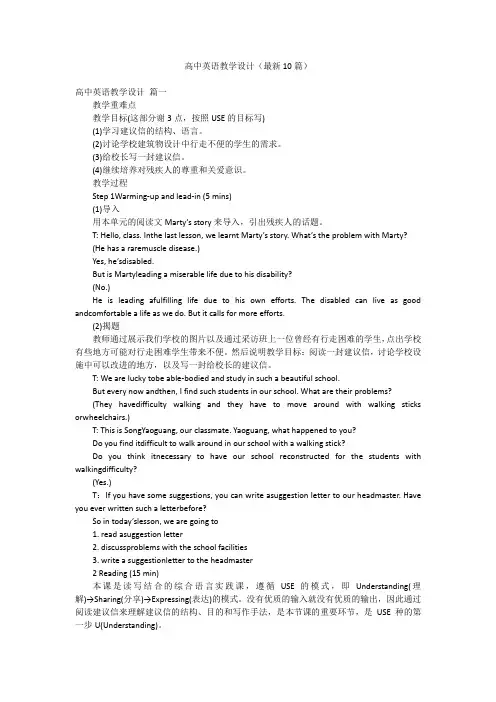
高中英语教学设计(最新10篇)高中英语教学设计篇一教学重难点教学目标(这部分谢3点,按照USE的目标写)(1)学习建议信的结构、语言。
(2)讨论学校建筑物设计中行走不便的学生的需求。
(3)给校长写一封建议信。
(4)继续培养对残疾人的尊重和关爱意识。
教学过程Step 1Warming-up and lead-in (5 mins)(1)导入用本单元的阅读文Marty’s story来导入,引出残疾人的话题。
T: Hello, class. Inthe last lesson, we learnt Marty’s story. What’s the problem with Marty?(He has a raremuscle disease.)Yes, he’sdisabled.But is Martyleading a miserable life due to his disability?(No.)He is leading afulfilling life due to his own efforts. The disabled can live as good andcomfortable a life as we do. But it calls for more efforts.(2)揭题教师通过展示我们学校的图片以及通过采访班上一位曾经有行走困难的学生,点出学校有些地方可能对行走困难学生带来不便。
然后说明教学目标:阅读一封建议信,讨论学校设施中可以改进的地方,以及写一封给校长的建议信。
T: We are lucky tobe able-bodied and study in such a beautiful school.But every now andthen, I find such students in our school. What are their problems?(They havedifficulty walking and they have to move around with walking sticks orwheelchairs.)T: This is SongYaoguang, our classmate. Yaoguang, what happened to you?Do you find itdifficult to walk around in our school with a walking stick?Do you think itnecessary to have our school reconstructed for the students with walkingdifficulty?(Yes.)T:If you have some suggestions, you can write asuggestion letter to our headmaster. Have you ever written such a letterbefore?So in today’slesson, we are going to1. read asuggestion letter2. discussproblems with the school facilities3. write a suggestionletter to the headmaster2 Reading (15 min)本课是读写结合的综合语言实践课,遵循USE的模式,即Understanding(理解)→Sharing(分享)→Expressing(表达)的模式。
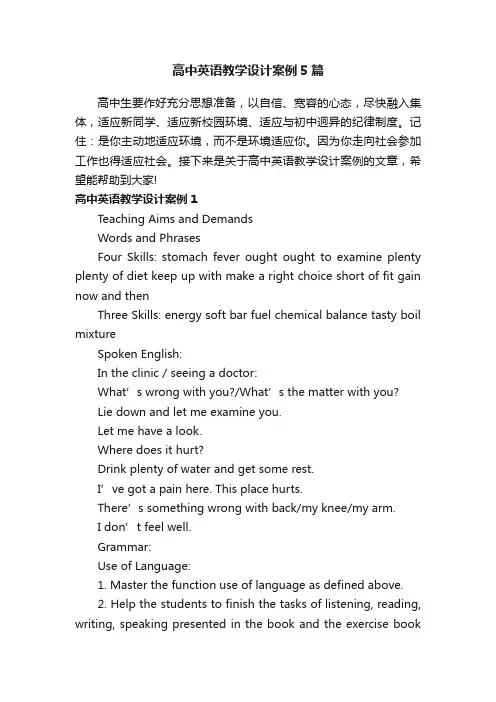
高中英语教学设计案例5篇高中生要作好充分思想准备,以自信、宽容的心态,尽快融入集体,适应新同学、适应新校园环境、适应与初中迥异的纪律制度。
记住:是你主动地适应环境,而不是环境适应你。
因为你走向社会参加工作也得适应社会。
接下来是关于高中英语教学设计案例的文章,希望能帮助到大家!高中英语教学设计案例1Teaching Aims and DemandsWords and PhrasesFour Skills: stomach fever ought ought to examine plenty plenty of diet keep up with make a right choice short of fit gain now and thenThree Skills: energy soft bar fuel chemical balance tasty boil mixtureSpoken English:In the clinic / seeing a doctor:What’s wrong with you?/What’s the matter with you?Lie down and let me examine you.Let me have a look.Where does it hurt?Drink plenty of water and get some rest.I’ve got a pain here. This place hurts.There’s something wrong with back/my kn ee/my arm.I don’t feel well.Grammar:Use of Language:1. Master the function use of language as defined above.2. Help the students to finish the tasks of listening, reading, writing, speaking presented in the book and the exercise bookthrough using what the students have learned.Learn the text about healthy eating. Get the students know about the basic knowledge of how to eat healthily.Important points:1. Talk about different kinds of food that one favorites.2. learn the basic knowledge of healthy eating.3. learn how to say in the clinic.4. Grasp the language points and grammar in the text.Difficult points: The use of modal verbs --- had better, should and ought to.Teaching aids: computer or slider-projectorWay of Teaching: Communication way of teaching, discussion and group work.Lesson 1Step 1 Warming-UpFirst show the students some pictures of dishes and so to introduce the topic of this unit.And then show the pictures on their text books and let them to decide what is junk food and what is not.Here the students may have a short ask and answer in pairs to themselves more engaged in the topic.Step 2 ListeningLet the students listen to the tape and be prepared to answer the questions below.Step 3 SpeakingShow the students the three situations as on P2. Then ask the students to prepared a dialogue according to the examples in pairs. Ask several pairs of students to present their dialogue After that list the useful expressions in their dialogue.Step 4 HomeworkPrepare for the next class.Collect some menus if possible for the next class.Lesson 2Step 1 IntroductionUsing the questions on P3 to introduce the new text.Step 2 Fast-reading1.What does the “fuel ” mean in the first paragraph?(It means different kinds of materials, such as protein, Calcium that we need to keep healthy.)2.What do we have to consider when we choose to buy or eat?(What kinds of nutrients that the food contain.)3.What made our eating habit changing?(Many things: what people believe, advice from companies and stores.)4. How can we feel and look fine?(We ought to learn about our body and the fuel it needs to keep fit.)Explain the language points if necessary.Step 3 Carefully-readingHow many parts can be divided into?(Three parts.)What’s the main idea of each part?(1.our eating habits are changing. 2.why the eating habits are changing 3.the best way to develop healthy eating habits.) Step 4 TalkingAsk the students to take out their menus and read them carefully. Then prepare a dialogue that may happen between a customer and a waiter/waitress.Step 5 HomeworkFinish the exercise --- Vocabulary on P5. and P72-73Lesson 3Step 1 RevisionCheck the homework.Step 2 GrammarFirst present the students the modal sentences with Modal Verbs and ask the students to make some sentences with them.Step 3 Consolidation(1) Finish the exercise on P5 and on P74(2)Take out a piece of paper with the column “Ask ###” in order to make the students understand when you are giving advice it is better to use some sentences with had better (not), and ought(not) to, should(not). Then read a passage as an example and afterwards list the points you have to pay attention to when you give advice.1.give advice that will really help the person.2. be polite and sincereat last get the students to finish the following practice.Step 4 HomeworkFinish the exercise 3 on P74 in the students’ workbook.Lesson 4Step 1 RevisionLet some students read their reply to the letters on P74.Step 2 ReadingRead the text on P6 and then get the students to find the main idea of it (Snacks is also important . we need to learn something about snacks and the way to prepare it.)Step 3 WritingAsk the students to work in pairs to write the recipe for their favourite dish.We may first give the tips on P7 as a guide.Step 4 DiscussionFirst ask the students to read the passage on P75 and then give the following questions as the topic for the students to talk: What is a couch potato?What does one have to pay special attention to in order to keep healthy? (food and exercise etc.)Step 5 HomeworkDo a general survey in order to learn about the differences between people’s eating habits and try to find which is healthier.高中英语教学设计案例2Teaching aims and demands:a. Achieve language skills and related knowledge about the topic of friends and friendship;b. Learn to express likes and dislikes and make apologies:c. Vocabulary in this unit:the words and expressions listed on the teacher’s bookd. Grammar:Direct and indirect speechLesson 1Step 1 Presentation and discussion (warm-up)Put some new words on the blackboard and tell them something about a friend.Kind honest brave loyal happy wise strongbeautiful handsome rich smart funnyThen ask some questions around the class and discuss with them.What should a good friend be like?What qualities should a good friend have?Should they be funny, smart and strong?Step 2 ReadingAsk the students to read the dialogue in the part SPEAKING. Ask some questions:1.What doesn’t John like?2.What does Joe think of music and skiing?And then fill in the form on page 3.Then ask the students to express their ideas freely. Encourage the students to say more about friends.Step 3ListeningAsk the students to listen to the tape and fill in the blanks in the listening part.Step 4 Talking/PracticeAsk the students to page 85. Make a similar dialogue as in exercise 2.Some useful expressions :Why did you…? Why didn’t you…? You said that you would…Please forgive me. You promised to … I’m very sorry… It won’t happen again. I forgot.Step 5 HomeworkFinish Exercise 3 in the workbook.Lesson2Step1 RevisionAsk several students to present a speech about friends as a revision.Step 2 Pre-readingPresent the students a picture to illustrate the situation on a lonely island. Ask them to list three items in the box and ask them to give the reasons using the sentences listed on page3.Step 3 ReadingBefore asking the students to read the text, first give the students a brief introduction about Tom Hanks, his films and the film Cast Away.Then students read the text, and answer the following questions.1.How does Chuck Noland come to a deserted island?2. In order to survive on the island alone, what does he need to learn?3. What does he understand at last?4. For us, what lesson we can learn from Chuck?At the same time explain the language points if necessary.Step 4 Post-readingDiscuss the following questions in the Part POST-READING.Step 5 HomeworkPrepare a talk about Tom Hanks or something about one of his film.Lesson3Step 1 RevisionGet the students to give a talk about Tom Hanks or something about one of his films.Step 2 Language StudyAsk the students fill in the blanks with proper words.Step 3 GrammarIllustrate to the students the use of Direct and Indirect Speech.Then ask the students to do the exercise in the Part Grammar on P5.Step 4 PracticeAsk the students to act the exercise2 in the part Grammar out.Step 5 HomeworkAsk the students to finish the exercise2 in their workbook.Lesson4Step 1 RevisionCheck the homework.Step 2 PresentationPresent simples of e-mail to get the students a general idea of e-mail.Step 3 ExplanationTell the students some tips of writing an e-mail by learn the above e-mail simple.Step 4 WritingAsk the students to write an e-mail message.Step 5 HomeworkAsk the students to try to write an e-mail to their e-pal.高中英语教学设计案例3Ⅰ. Teaching Basis (教学依据) :《普通高中英语新课程标准》Ⅱ. The Type of the Text (课型) :Revision (复习课)Ⅲ. Teaching Methods(教学方法): Question-based method(提问式),Group discussionmethod(小组讨论法),Cooperative learning(合作探究),Practicing(练习).Ⅳ. Teaching Aids (教学手段) :Multimedia computer(多媒体电脑),Learningpaper(导学案),Blackboard(黑板).Ⅴ. Teaching Aims(教学目标) :①Knowledge aims(知识目标): words: achievement, specialist, organization, hard-working, confident….. phrases: put to death, mean doing, either…or…, the bond between……, structure: only+…., It is/was+….+that…. grammar: Subject-verb agreement.②Ability aims(能力目标): Develop the students’ ability to use the importantlanguage points, enable students to describe people using the adjectives.③Emotional aims(情感目标): Encourage the students to think about what makes aperson great.Ⅵ. Teaching focuses(教学重点):Get the students to review and consolidate what theyhave learned in this unit.Ⅶ. Teaching difficulties(教学难点):Get the students to turn what they have learned intotheir ability.Ⅷ.Teaching procedure(教学过程): Step 1 复习学案情况反馈(1分钟)Step 2 lead-in :通过图片展示的方式,过渡到知识竞答类节目《一站到底》,本节课也将模仿这种模式授课。
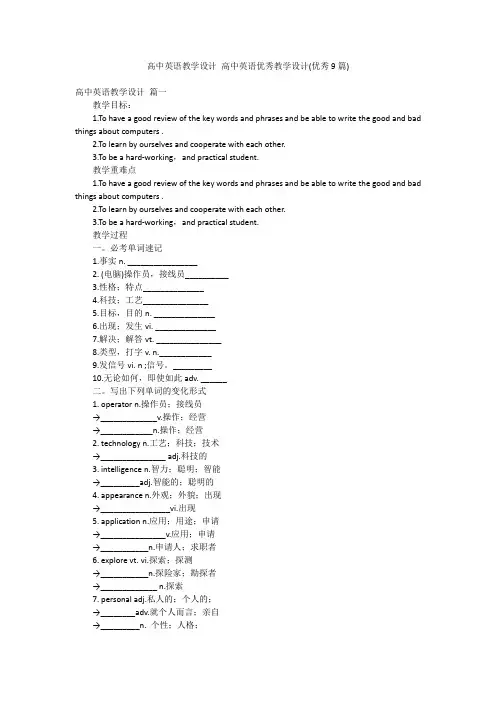
高中英语教学设计高中英语优秀教学设计(优秀9篇)高中英语教学设计篇一教学目标:1.To have a good review of the key words and phrases and be able to write the good and bad things about computers .2.To learn by ourselves and cooperate with each other.3.To be a hard-working,and practical student.教学重难点1.To have a good review of the key words and phrases and be able to write the good and bad things about computers .2.To learn by ourselves and cooperate with each other.3.To be a hard-working,and practical student.教学过程一。
必考单词速记1.事实n. ________________2. (电脑)操作员,接线员__________3.性格;特点______________4.科技;工艺_______________5.目标,目的n. ______________6.出现;发生vi. ______________7.解决;解答vt. _______________8.类型,打字v. n.____________9.发信号vi. n ;信号。
_________10.无论如何,即使如此adv. ______二。
写出下列单词的变化形式1. operator n.操作员;接线员→_____________v.操作;经营→____________n.操作;经营2. technology n.工艺;科技;技术→_______________ adj.科技的3. intelligence n.智力;聪明;智能→_________adj.智能的;聪明的4. appearance n.外观;外貌;出现→________________vi.出现5. application n.应用;用途;申请→_______________v.应用;申请→___________n.申请人;求职者6. explore vt. vi.探索;探测→___________n.探险家;勘探者→_____________ n.探索7. personal adj.私人的;个人的;→________adv.就个人而言;亲自→_________n. 个性;人格;三、用所给词的适当形式填空(1)Can you say dolphins are much more ____________than other animals?Well, they are animals of high _____________. (intelligent)(2) She expressed her _________ opinion yesterday. ____________ speaking, I agreed with what she said. (personal)(3) Any ___________ who would like to _____________ to become anassistant in our company should send us an ___________ .(apply)四、语境助记——词不离句,句不离段With the electronic technology revolution going on,simplified calculation is solved in the application on finance by universal exploration. Our goal of making life happier is certain to be realized through man's intelligence.五、翻译下列必背短语?1.在某种程度上_______________2.依…看;据…认为_____________3.从…时候起_______________4.结果_______________5.处理;安排;对付____________6.弥补,补足;整理,编造_________7.毕竟_______________?8.看守,监视_______________9.在……帮助下_______________?六。
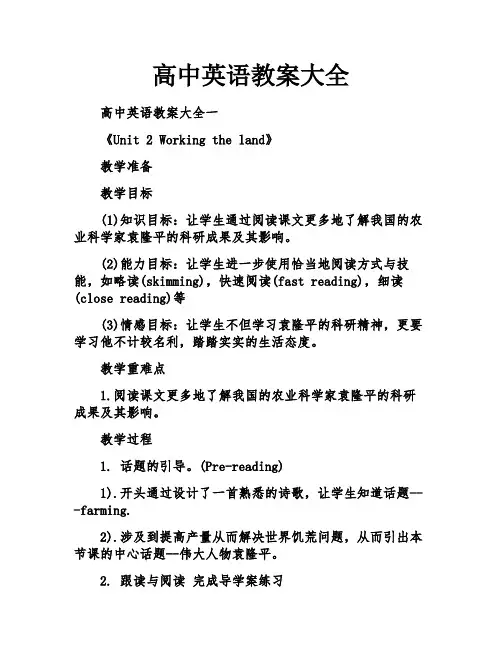
高中英语教案大全高中英语教案大全一《Unit 2 Working the land》教学准备教学目标(1)知识目标:让学生通过阅读课文更多地了解我国的农业科学家袁隆平的科研成果及其影响。
(2)能力目标:让学生进一步使用恰当地阅读方式与技能,如略读(skimming),快速阅读(fast reading),细读(close reading)等(3)情感目标:让学生不但学习袁隆平的科研精神,更要学习他不计较名利,踏踏实实的生活态度。
教学重难点1.阅读课文更多地了解我国的农业科学家袁隆平的科研成果及其影响。
教学过程1. 话题的引导。
(Pre-reading)1).开头通过设计了一首熟悉的诗歌,让学生知道话题---farming.2).涉及到提高产量从而解决世界饥荒问题,从而引出本节课的中心话题--伟大人物袁隆平。
2. 跟读与阅读完成导学案练习贯彻目的与困难策略,指导学生根据不同的阅读目的,在阅读的不同阶段,灵活使用各种阅读策略,捕捉文章主要信息,理解作者的写作意图,突破本文的教学重点与难点。
采用整体语言教学法和任务型语言教学法。
1)、通过阅读训练,引导学生如何利用略读(skimming)的方法把握文章的大意,侧重培养快速阅读理解能力和文章中心把握能力。
2)、精读各个段落语段,侧重培养快速捕捉文章重要细节的能力和猜测生词的能力,学会欣赏文章中的优美句子。
3:阅读过程--浅层次阅读。
(Reading I)1). 其中关于人物的基本信息中,通过设计了一个信息表格的浅层次阅读练习,对文中人物有了初步了解。
2). 关于他的梦想,书本上描写得非常生动,我让班里有艺术特长的学生画了一幅漫画,利用画面反映课文第四段所描述的内容,同时用第一人称配了声音效果。
4. 阅读过程--深层次阅读。
(Reading II)在处理了一些简单信息之后,阅读人物最重要的是要读出人物不同于其他人的成就以及值得学生学习的一些可贵品质。
就这两方面的内容,设计了一棵树的形象,引导学生去寻找袁隆平作出的成就以及他身上拥有的可贵品质。
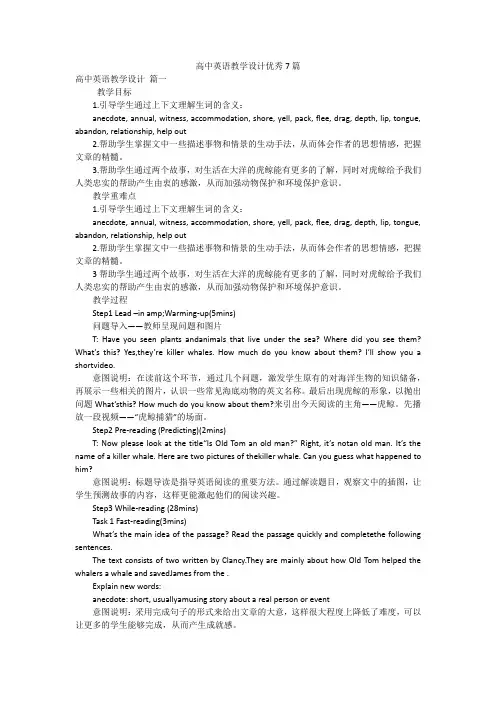
高中英语教学设计优秀7篇高中英语教学设计篇一教学目标1.引导学生通过上下文理解生词的含义:anecdote, annual, witness, accommodation, shore, yell, pack, flee, drag, depth, lip, tongue, abandon, relationship, help out2.帮助学生掌握文中一些描述事物和情景的生动手法,从而体会作者的思想情感,把握文章的精髓。
3.帮助学生通过两个故事,对生活在大洋的虎鲸能有更多的了解,同时对虎鲸给予我们人类忠实的帮助产生由衷的感激,从而加强动物保护和环境保护意识。
教学重难点1.引导学生通过上下文理解生词的含义:anecdote, annual, witness, accommodation, shore, yell, pack, flee, drag, depth, lip, tongue, abandon, relationship, help out2.帮助学生掌握文中一些描述事物和情景的生动手法,从而体会作者的思想情感,把握文章的精髓。
3帮助学生通过两个故事,对生活在大洋的虎鲸能有更多的了解,同时对虎鲸给予我们人类忠实的帮助产生由衷的感激,从而加强动物保护和环境保护意识。
教学过程Step1 Lead –in amp;Warming-up(5mins)问题导入——教师呈现问题和图片T: Have you seen plants andanimals that live under the sea? Where did you see them? What’s this? Yes,they’re killer whales. How much do you know about them? I’ll show you a shortvideo.意图说明:在读前这个环节,通过几个问题,激发学生原有的对海洋生物的知识储备,再展示一些相关的图片,认识一些常见海底动物的英文名称。
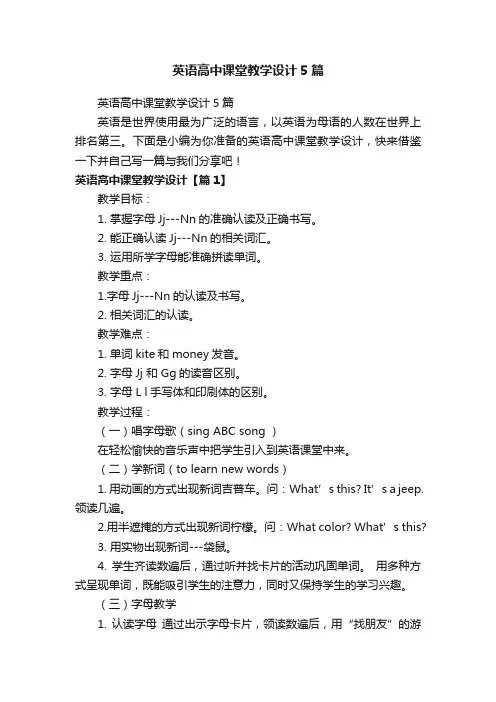
英语高中课堂教学设计5篇英语高中课堂教学设计5篇英语是世界使用最为广泛的语言,以英语为母语的人数在世界上排名第三。
下面是小编为你准备的英语高中课堂教学设计,快来借鉴一下并自己写一篇与我们分享吧!英语高中课堂教学设计【篇1】教学目标:1. 掌握字母Jj---Nn的准确认读及正确书写。
2. 能正确认读Jj---Nn的相关词汇。
3. 运用所学字母能准确拼读单词。
教学重点:1.字母Jj---Nn的认读及书写。
2. 相关词汇的认读。
教学难点:1. 单词kite和money发音。
2. 字母Jj 和 Gg的读音区别。
3. 字母L l手写体和印刷体的区别。
教学过程:(一)唱字母歌(sing ABC song )在轻松愉快的音乐声中把学生引入到英语课堂中来。
(二)学新词(to learn new words)1. 用动画的方式出现新词吉普车。
问:What’s this? It’s a jeep. 领读几遍。
2.用半遮掩的方式出现新词柠檬。
问:What color? What’s this?3. 用实物出现新词---袋鼠。
4. 学生齐读数遍后,通过听并找卡片的活动巩固单词。
用多种方式呈现单词,既能吸引学生的注意力,同时又保持学生的学习兴趣。
(三)字母教学1. 认读字母通过出示字母卡片,领读数遍后,用“找朋友”的游戏巩固字母大小写。
既:老师把所学字母卡片的大小写分别发给学生,在听到教师“let’s go”的指令下,学生快速跑到前面并找到自己相应的大小写字母站好。
2. 融会贯通当学生找好相应的大小写字母并站好后,坐在位子上的学生一齐问:“What’s your name ?拿着卡片的学生答:My name is Jj /Kk/Ll……(本册书第一单元的重点句)。
教师任意指着一个字母问:Who’s this/that?学生答:This is Jj/Kk...(本单元重点句)把所学句型应用到字母教学中来,既为枯燥的字母教学创设了语言环境,同时又让学生体会到了语言的灵活性,让他们把所学知识得到了具体的应用。
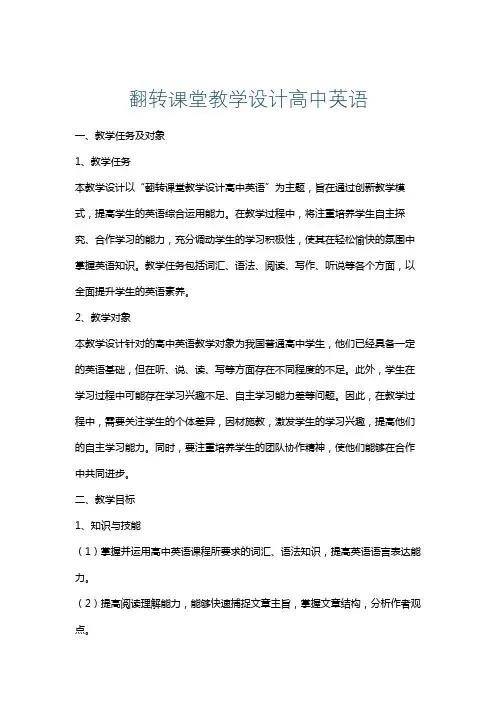
翻转课堂教学设计高中英语一、教学任务及对象1、教学任务本教学设计以“翻转课堂教学设计高中英语”为主题,旨在通过创新教学模式,提高学生的英语综合运用能力。
在教学过程中,将注重培养学生自主探究、合作学习的能力,充分调动学生的学习积极性,使其在轻松愉快的氛围中掌握英语知识。
教学任务包括词汇、语法、阅读、写作、听说等各个方面,以全面提升学生的英语素养。
2、教学对象本教学设计针对的高中英语教学对象为我国普通高中学生,他们已经具备一定的英语基础,但在听、说、读、写等方面存在不同程度的不足。
此外,学生在学习过程中可能存在学习兴趣不足、自主学习能力差等问题。
因此,在教学过程中,需要关注学生的个体差异,因材施教,激发学生的学习兴趣,提高他们的自主学习能力。
同时,要注重培养学生的团队协作精神,使他们能够在合作中共同进步。
二、教学目标1、知识与技能(1)掌握并运用高中英语课程所要求的词汇、语法知识,提高英语语言表达能力。
(2)提高阅读理解能力,能够快速捕捉文章主旨,掌握文章结构,分析作者观点。
(3)培养英语写作能力,能够独立完成各类作文,如叙述文、议论文、说明文等。
(4)提高英语听力水平,能够理解日常生活中的对话及短文,获取关键信息。
(5)锻炼英语口语表达能力,能够在生活中进行简单的交流,具备一定的交际能力。
2、过程与方法(1)采用翻转课堂模式,引导学生课前自主学习,培养自主探究能力。
(2)课中开展小组合作学习,培养学生团队协作精神和解决问题的能力。
(3)通过课堂讨论、实践操作等方式,提高学生的思维能力和创新意识。
(4)运用多媒体教学手段,丰富教学资源,提高学生的学习兴趣。
(5)注重学法指导,让学生掌握有效的学习方法,提高学习效率。
3、情感,态度与价值观(1)培养学生对英语学习的兴趣,激发学习动力,形成积极的学习态度。
(2)培养学生具有合作精神,尊重他人,善于倾听,乐于助人。
(3)培养学生具备跨文化意识,了解并尊重不同文化背景下的价值观和行为方式。
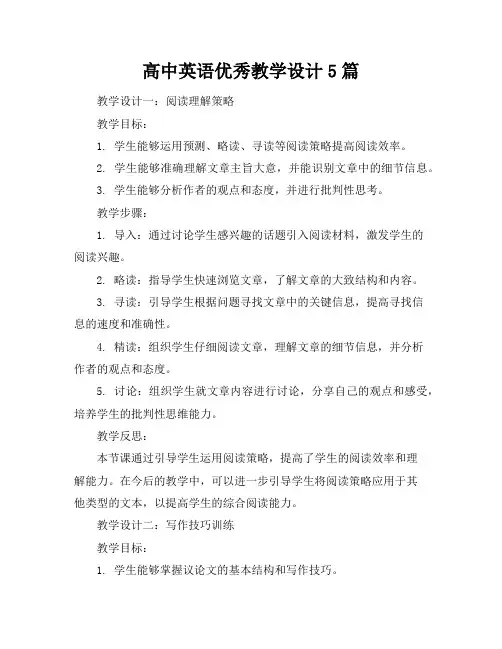
高中英语优秀教学设计5篇教学设计一:阅读理解策略教学目标:1. 学生能够运用预测、略读、寻读等阅读策略提高阅读效率。
2. 学生能够准确理解文章主旨大意,并能识别文章中的细节信息。
3. 学生能够分析作者的观点和态度,并进行批判性思考。
教学步骤:1. 导入:通过讨论学生感兴趣的话题引入阅读材料,激发学生的阅读兴趣。
2. 略读:指导学生快速浏览文章,了解文章的大致结构和内容。
3. 寻读:引导学生根据问题寻找文章中的关键信息,提高寻找信息的速度和准确性。
4. 精读:组织学生仔细阅读文章,理解文章的细节信息,并分析作者的观点和态度。
5. 讨论:组织学生就文章内容进行讨论,分享自己的观点和感受,培养学生的批判性思维能力。
教学反思:本节课通过引导学生运用阅读策略,提高了学生的阅读效率和理解能力。
在今后的教学中,可以进一步引导学生将阅读策略应用于其他类型的文本,以提高学生的综合阅读能力。
教学设计二:写作技巧训练教学目标:1. 学生能够掌握议论文的基本结构和写作技巧。
2. 学生能够运用论据和论点进行有效的论证。
3. 学生能够进行自我修改和同伴互评,提高写作水平。
教学步骤:1. 导入:通过分析优秀议论文,引导学生了解议论文的基本结构和写作技巧。
2. 写作指导:讲解议论文的写作步骤,包括确定论点、寻找论据、组织文章结构等。
3. 实践练习:组织学生进行写作练习,并鼓励学生运用所学技巧进行创作。
4. 同伴互评:引导学生进行同伴互评,互相提出修改建议,提高写作水平。
5. 自我修改:指导学生根据同伴互评和自我反思进行修改,完善文章。
6. 展示与分享:组织学生展示自己的作品,并分享写作心得和体会。
教学反思:本节课通过讲解写作技巧和实践练习,提高了学生的写作能力。
在今后的教学中,可以进一步引导学生关注写作过程中的细节问题,如语法、拼写、标点等,以提高学生的写作质量。
教学设计三:口语交际能力提升教学目标:1. 学生能够运用恰当的口语表达技巧进行日常交流。
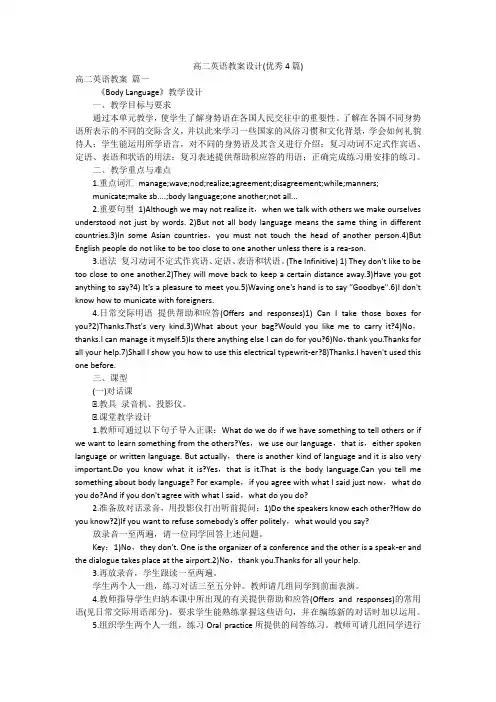
高二英语教案设计(优秀4篇)高二英语教案篇一《Body Language》教学设计一、教学目标与要求通过本单元教学,使学生了解身势语在各国人民交往中的重要性。
了解在各国不同身势语所表示的不同的交际含义,并以此来学习一些国家的风俗习惯和文化背景,学会如何礼貌待人;学生能运用所学语言,对不同的身势语及其含义进行介绍;复习动词不定式作宾语、定语、表语和状语的用法;复习表述提供帮助积应答的用语;正确完成练习册安排的练习。
二、教学重点与难点1.重点词汇manage;wave;nod;realize;agreement;disagreement;while;manners;municate;make sb....;body language;one another;not all...2.重要句型1)Although we may not realize it,when we talk with others we make ourselves understood not just by words. 2)But not all body language means the same thing in different countries.3)In some Asian countries,you must not touch the head of another person.4)But English people do not like to be too close to one another unless there is a rea-son.3.语法复习动词不定式作宾语、定语、表语和状语。
(The Infinitive) 1) They don't like to be too close to one another.2)They will move back to keep a certain distance away.3)Have you got anything to say?4) It's a pleasure to meet you.5)Waving one's hand is to say ”Goodbye".6)I don't know how to municate with foreigners.4.日常交际用语提供帮助和应答(Offers and responses)1) Can I take those boxes for you?2)Thanks.Thst's very kind.3)What about your bag?Would you like me to carry it?4)No,thanks.I can manage it myself.5)Is there anything else I can do for you?6)No,thank you.Thanks for all your help.7)Shall I show you how to use this electrical typewrit-er?8)Thanks.I haven't used this one before.三、课型(一)对话课Ⅰ.教具录音机、投影仪。
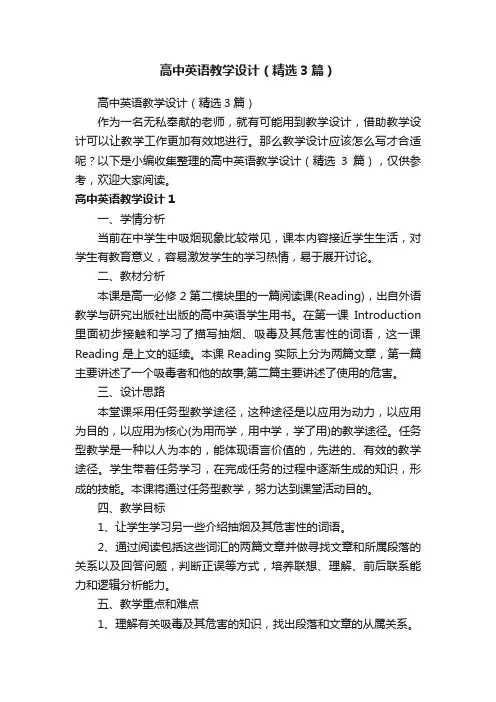
高中英语教学设计(精选3篇)高中英语教学设计(精选3篇)作为一名无私奉献的老师,就有可能用到教学设计,借助教学设计可以让教学工作更加有效地进行。
那么教学设计应该怎么写才合适呢?以下是小编收集整理的高中英语教学设计(精选3篇),仅供参考,欢迎大家阅读。
高中英语教学设计1一、学情分析当前在中学生中吸烟现象比较常见,课本内容接近学生生活,对学生有教育意义,容易激发学生的学习热情,易于展开讨论。
二、教材分析本课是高一必修2第二模块里的一篇阅读课(Reading),出自外语教学与研究出版社出版的高中英语学生用书。
在第一课Introduction 里面初步接触和学习了描写抽烟、吸毒及其危害性的词语,这一课Reading是上文的延续。
本课Reading实际上分为两篇文章,第一篇主要讲述了一个吸毒者和他的故事;第二篇主要讲述了使用的危害。
三、设计思路本堂课采用任务型教学途径,这种途径是以应用为动力,以应用为目的,以应用为核心(为用而学,用中学,学了用)的教学途径。
任务型教学是一种以人为本的,能体现语言价值的,先进的、有效的教学途径。
学生带着任务学习,在完成任务的过程中逐渐生成的知识,形成的技能。
本课将通过任务型教学,努力达到课堂活动目的。
四、教学目标1、让学生学习另一些介绍抽烟及其危害性的词语。
2、通过阅读包括这些词汇的两篇文章并做寻找文章和所属段落的关系以及回答问题,判断正误等方式,培养联想、理解、前后联系能力和逻辑分析能力。
五、教学重点和难点1、理解有关吸毒及其危害的知识,找出段落和文章的从属关系。
2、培养阅读时的联想、理解、前后联系的能力和逻辑分析能力。
3、阅读的同时也培养学生运用所学的词汇进行语言交际的能力。
六、教学辅助手段CAI课件,录音机。
七、教学过程(略)高中英语教学设计2一、课题准备与启动阶段情况为了更好地开展《高中英语参与式教学设计研究》课题的研究,自申报课题开始,课题组就开始积极查阅、收集相关资料,学习相关理论,制定了课题研究方案。
高中英语优秀教案范例【篇一:高中英语教学设计】第三届全国中小学“教学中的互联网搜索”优秀教案评选教学设计教学过程step1 lead-int: “good morning, boys and girls! have you had your breakfast? s: yes/not: if you did not have your breakfast, what’s your feeling now? are you feeling hungry now?【设计意图】首先通过自由交流的方式,老师提问学生回答的方式,进行导入和热身活动,减轻学生上课伊始的紧张感,快速地融入课堂,成为课堂教学活动的主体。
today i will show you some pictures, and please tell me whatis happening to these people.they are facing the problem of hunger.what do they need most?maybe a bowl of rice or noodles is their best choice.【设计意图】首先给学生展示一些有关非洲饱受饥饿折磨的儿童图片,让学生从直观上先受到触动,从心底里同情这些遭受饥饿的孩子,使学生在浏览图片事受到心灵上的震撼并激起他们对本课话题的兴趣。
do you know how to get rice?show them some pictures about the procedures of rice planting.plowing the fieldgrowing young plantsinserting young plants into the fieldfertilizinggrowing harvestingfinally we get rice.【设计意图】由于地处北方地区,大多数学生不了解水稻等生产,故而设置问题do you know how to get rice? 同时该问题的提出,让学生的思维巧妙地过渡到课文中。
高中英语教资教案4篇高中英语教资教案篇1【课题】Unit 5 Lesson 25【重点】第三人称做主语,拼写他人名字,询问与他人有关的问题。
根据音标词能够正确拼写出单词。
【难点】its 和it’s 的辨析。
询问与他人有关的问题。
【过程】一、热身/ 复习(warm-up / revision)日常口语会话。
游戏:猜猜他是谁。
教师叙述,学生猜,如果学生程度较高,也可以由学生来叙述。
eg: There is a boy. He has short hair, small nose… Who is he?学生用He is … 或His name is…回答。
说说自己:介绍一下自己的情况,复习第四单元内容,同时为新课做准备。
二、呈现新课(presentation)教师展示图片 ( 小猫和小鸟 )教师问:Who is she? Who is he? What are their names?Do you know how to spell their names?教师播放腾图教育资源中的配套课件。
回答刚才教师的提问。
模仿课文对话。
教师播放声音,学生跟读。
两人一小组,练习对话。
请几组到前面来表演。
学习单词:教师读词,由学生试着拼字母。
教师带读单词。
学生做拼读练习。
游戏:看看哪组写的快:发给每组一张小纸条,从排头开始写:Can you spell your name?这句话,然后向后传,看哪组写得快,哪组写得好。
三、趣味操练(practice)给课件配音:教师播放课件,但关掉声音,由学生来配音。
自编小对话:学生自愿结合,编写小对话。
请几组到前面来表演。
师生共同给予评价。
看图练习:教师或学生做示范:I have a bird. Its name is [′pCli ]. [ ka:l] [′mimi] [rEUz] [sAm] [keit] Can you spell its name?让几个同学模仿。
( 第51页练习 )待学生明白教师的要求后,学生在小组中练习。
高一英语教案精选6篇高一英语教案精选6篇高一英语教案1 一、利用表象,丰富想象观察图画和实物作文符合英语作文起步阶段需要有一定的情景要求,也符合高中学生有意想象占优势的特点,同时防止了文字情节作文易使学生中译英的缺点,但假设每一次训练都是刻板的再现材料,创造想象那么难以增长。
假设在教学设计时,在图中留有空白,或对实物设置悬念,不仅可以引发学生的好奇心,激发他们对英语作文的兴趣,减轻他们的惧怕心理,而且可以促使学生通过创造性的想象去填补空白,解决悬念。
如senior bookⅰ,unit 3 中的“help! help!”,可按开展顺序设计几幅救落水儿童的图,但只给学生展示第一、二两幅图,图画的内容大致与课文内容一样,但是后几幅的空白,使学生必须通过创造性的想象才能填补材料的空白。
学生可以引用课文中的材料,也可以自由发挥。
有学生这样写到:last week, we had a picnic in forest park。
we found a shady place by the river。
as soon as we had sat down, tom suddenly got up and shouted,“someonehas fallen into the river!" it was true。
a boy was struggling in the water, and the children in a boat looked hopeless。
tom and jack took off their shoes while running to wards the water。
they swam very quickly towards the boy who was sinking fast。
tom and jack got hold of the boy by the arms and lifted his head above the water。
高中英语教案设计参考(精选9篇)高中教师的英语教学设计篇一教学准备教学目标教学目标1、Ability goals 能力目标To help the Ss develop their reading ability by skimming for main ideas and car eful-reading for details with the teacher’s guidance.To get The Ss to master some key words such as witness, abandon, yell, drag, flee and so on.2、Learning ability goals 学能目标To enable the Ss to talk about animals under the sea.To help the Ss know the importance of the relationship between animals and humans.教学重难点教学重点和难点Teaching important points 教学重点Help the Ss know more about animals under the sea as well as the animals’ loyalty and help to human bein gs.Teaching difficult points 教学难点1、Help the Ss get the main idea and some detailed information by fast-reading and careful-reading.2、Help the Ss tell apart from Before, During and After in the story.教学过程Step1. Warming Up : Talk about animals under the sea.1、Have you ever seen some marine animals?2、What have you seen, and where have you seen them?I have seen a/some/many…… in/on/from……amazing marine animals: seal, turtle, dolphin, sea-horse, sea-star, shark, angelfish, jellyfish, lobster, coralStep2. Fast-reading:1、Find out the Background Information of the story : writer, career, writing style, time, place, main character.2、Find out the Main Idea of the passage: What’s the first story mainly about?Step3. Careful-reading:1、Clancy had heard of the killer whales that every year killer whales would help whalers catch baleen whales. Did he believe it at first? When did he believe it was a true anecdote?2、How many paragraphs are there all together in story1? The hunt can be divided into 3 stages.Stage1: before the hunt: (para. 2-6):Old Tom’s doing: throwing itself out of … and crashing down again… Why? to tell the whalers…,…by the boat…,circling back to …Why? to lead the whalers…Whalers’ reaction: Another whaler __________. George _____ ___ _____ Clancy, and Clancy ______ after him. They __________ the boat and ______ ____into the bay.Stage2amp;3: Dur ing and after the hunt: (para. 7-9):Killer whale’s doing: The killers over there are ________ themselves on the top of the whale’s blow-hole to stop it __________; and some others are stopping it _______ out to sea. The killers started ________ between our boat and the whale just like a pack of ____ ___ dogs. When the baleen whale was dead, its body wa s _______ down into the depths of the sea.Whalers’ reaction: The man in the bow of the boat aimed the harpoon at the whale and then let it go to hit the spot.Conclusion: They have amazing relationship. They work as a teamStep4 : SummaryWorking at the _______station, I had the chance to _________ a baleen whale being attacked by a ______ of k iller whales.On the afternoon I arrived at the station, as I was __________ my accommodation, I heard a loud noise coming from the bay. I ran down to the ______ in time to see an enormous animal _________ itself out of the water and then _______________ again. George told me it was Old Tom, who announced there would be a ___________.Using a _________, we could see a baleen whale _______________ by about six killers. Some are ________ themselves on top of the whale’s __________to stop it breathing; and some others are stopping it _______ out to sea. The whalers aimed the ________ at the whale and then let it go to hit the spot. Being badly ________, the whale soon died. Very soon, its body was ________ by the killers down into the _______ of the sea.课后习题课后作业Deal with Exercise 3 in Comprehending 。
高中英语教案(优秀8篇)高中英语教学设计篇一单元整体设计思路第一课时:阅读课Warming up; Pre-reading; Reading; Comprehending (pp. 1-2)第二课时:语法课Discovering useful structures (p. 4); Using structures (p. 43)第三课时:阅读与听说课Reading and listening; Speaking (pp. 5-6)第四课时:词汇课Discovering useful words and expressions (p. 3); Using words and expressions (p. 42)第五课时:听说课Listening; Talking (p. 41)第六课时:读写课Reading and writing (p. 7)第七课时:单元评价课Self-test and self-evaluation; Summary第一课时阅读课一、教学内容Warming up; Pre-reading; Reading; Comprehending (pp. 1-2)二、教学目标在本节课结束时,学生能够了解文化遗产的基本概念、本质特点以及基本类型。
通过找读(scanning)关键词、略读(skimming) 和精读(careful reading),了解有关琥珀屋的故事。
用归类法学习词汇。
用自己的话复述琥珀屋的故事。
运用本课时学习的内容和自己已有的知识讨论相关话题。
三、教学步骤步骤一热身1.请学生看学生用书p. 1或者PPT中的图片,两人一组讨论三个问题。
教师请几组学生回答问题,然后综合大家的看法总结出文化遗产的定义。
2. 请学生说出一些中外文化遗产的名称,教师写在黑板上。
可以采取小组竞赛的形式,比一比看哪组说得多、说得正确。
注:问题中出现了五个生词。
rare, valuable和survive很难根据上下文猜出词义,教师可以布置学生课前查字典自学其词义,用法可以留到词汇课处理。
高中英语优秀教案(优秀7篇)高中英语教学设计篇一知识目标:复习两个阅读技能——scanning,skimming;学习本单元的部分生词。
本事目标:能构成文章的图式,在图式的帮忙下自主地复述本课的主要资料,在此过程中实现生词的重现。
情感目标:学生在教师的启发下,经过师生互动和生生互动,进一步探究知识。
在这一过程中,学生能够不断地实现互相教育和自我教育,并能寻求自我发展;学生能明白计划的重要性,并能收获一些与之相关的谚语。
教学重难点构成文章的`图式,并在图式的帮忙下复述文章的主要资料。
教学工具课件教学过程StepsTeacher’s activityStudents’ activityAimsStep 1Show and tell the students the learning goals for them and make possible explanationsStudents listen to the teacher and have an idea of what they are going to learn in this class。
To make the students know what they are to learn in this classStep 21)、Show some pictures with beautiful scenery2) Ask the students two questions:Are they attractive?Where do you want to travel? – I dream about traveling…1)Students appreciate those pictures2) Students answer teacher’s questions and practice the sentence pattern “I dream about traveling into…”1) To arouse students’ interest2) To practice a sentence patternStep 31) Show the title of the reading passage2) Ask the students whether this passage is about the whole process of the journey。
高中英语课堂教学设计
摘要:在教学过程中,设计合理的教学步骤,能让学习短时高效,学生兴奋投入。
而以学生为主体、有目的地自学、进行学生互教和做大量难度等级不同的练习,则有利于巩固教学内容,取得良好的教学效果。
关键词:教学方法;自学;指导;落实
中图分类号:G632.0 文献标识码:A 文章编号:1992-7711(2014)04-0035
以“素质教育、培养学生的创新精神和实践能力”为目标的新一轮的教学改革正在全国各地如火如荼地进行着;教材要求教师教学活动的设计,主要是为了启发学生思考,提倡创新,获取信息、分析信息、分析问题和解决问题的能力,以培养学生综合运用英语为目标的教学贯穿于整个教学中。
自新课改以来,为避免“填鸭式”教学,推广素质教育,各校研究出了多种新型教学方法。
其中,永威中学的“先学后教”课堂教育模式就很受欢迎,各校竞相模仿,以期取得更好的教学效果。
然而,笔者认为,在具体教学过程中,各地各科甚至各班学生都不尽相同,我们应该取各家之长、灵活运用、反思创新,才能研究出最适合自己班的教学方法。
英语教学有极强的实践性、交际性,它同样具备创造性教学模式的如下特征,即流畅性、变通性、独创性、完美
性。
以学生作为创造活动的主体,在教师的诱导下形成交际能力是该学科的目的。
因此,教师与学生必须处理好互动关系。
所谓“互动”,就是以教师为主导、以学生为主体,教学中在教师的启发下引导学生去发现,在学生发现的要求下,促使教师去启发,师生密切配合,在和谐、愉快的情境中实现教与学的共振,成功的英语教学要致力于形成一种新的教学双边关系,使得两个最重要的要素的作用得到和谐而充分的发挥。
教师抓住时机善于引导、教学方法灵活多变,教学内容引人入胜;学生在教师的诱导下善于思考,积极参与,使其能力不断发展。
今年笔者带的是两个高二文科班,学生水平参差不齐,针对学生特点,笔者不断反思更正,确定了适合他们的教学方法。
下面,笔者就谈一下自己的拙见。
英语课堂设计步骤:
一、导课
有些教师认为,为了巩固教学效果,就应该直入主题,少讲多练。
但英语教学不同于其他学科,大部分学生基础差,对他们来说英语枯燥乏味,所以首先要调动起他们的兴趣,即激趣。
因为“兴趣是最好的老师”。
激发兴趣之目的,是变逼为导,变苦学为乐学。
把求知变成学生最大的内在需要。
因此,我们用“爱”促进教育,用“趣”构建教育模式,用“玩”组织教学活动,充分发挥师生的互动作用。
采用多姿
多彩的导入形式,是为创造良好课堂教学情景做准备。
课堂教学导入有时也被叫做热身活动。
Warming-up exercise是课堂教学的起始环节。
在课堂教学中广泛采用的导入有多种:如事例导如、问题导入、妙语导入、审题导入、自荐导入等。
对中学生学习外语而言,单调乏味的开场白往往提不起学生的学习兴趣,只有丰富多采、求新猎奇的活动菜单才能使学生胃口大开。
因此,教师在课堂教学中要敢于标新立异,创造多姿多彩的课堂教学导入形式,从听听说说、读读写写、玩玩唱唱中引入课文,让学生尽快进入最佳的学习状态,为教学情景的展开做好铺垫。
例如,选修七的第三单元――Under the sea中的using language――A new dimension of life,这是一篇泛读课,要求学生具备综合阅读的能力,能快速有效的掌握文章内容。
作为文科生,对海洋的基本知识有一定的了解。
因此,对于本课的导课,笔者就从一个简单的小游戏开始,让学生分组比赛,看谁能说出更多的关于海洋的知识。
创造热闹的学习氛围,成功吸引学生注意力。
接下来利用多媒体展示大量海洋生物的图片,让学生猜名字,进一步激发兴趣。
这样,这节课就有了一个良好的开端,为学生更加积极主动地获取知识做好了准备。
二、呈现
即presentation,运用不同方法将课文内容全面呈现出来,这一阶段是培养学生综合阅读能力的关键。
结合新教
法,笔者对自己的教学也进行了反思和创新。
具体过程如下:
1. 简明扼要的出示教学目标,让学生齐读,加深印象,明确学习目的。
2. 预测。
针对阅读课,这是非常一个必要的步骤。
通过文章标题、副标题、小标题和插画等预测课文内容,必要时可看一下文章首句。
了解general idea,对学生进一步学习有很大帮助,尤其是对差生来说,减轻了心理负担。
3. 自学。
永威的先学后教教育模式强调要让学生自己动脑思考,自学当堂内容。
这样更有助于巩固知识,但是完全的自学并不适应英语教学,可能会导致学生走神或浪费课堂时间,所以,我对这种方法进行了一些改变。
首先,对学生进行鼓励,相信他们一定能短时高效的完成教学要求,必要时,带领学生喊口号,如:I can make it.或者I believe I can do it.或者I’m confident.通过心理暗示,让学生带着激情去学习。
接下来,提供自学指导,让学生知道他们需要自学什么内容,怎样进行自学、可以用多长时间,最后要达到什么要求等等。
学习有了具体的范围和要求,而且有了规定的时间限制,这样可以使学生在学习时有了一定的压力,适当增加学习的紧张程度,提高学生自学的效率。
学生自学前的指导一定要具体、明确,这样学生在学习时心中有数,才能在自学的过程中增强针对性,提高学习的效率。
但是这一阶段的时间要控制在五分钟之内,自学要求也不要太
高,主要掌握文章大意,用时太多会导致学生疲惫。
学习过程中,一般要求默读,运用skimming和scanning的阅读方法。
4. 先学后教。
(1)先学,自学之前,提出思考题,如是阅读文章,可用使用课后comprehending的问题稍加改变。
语法课可在容易混淆的地方提出疑问。
如学习定语从句the attributive clause,可提问关系代词和关系副词在句子中各做什么成分,有什么区别。
或出几个简单的选择题让学生辨析。
另外,教师要在“先学”这一阶段,通过提问、讨论、学生板演等形式,让学生最大限度地暴露自学中遇到的问题,并对这些问题进行一定的分析判断和归类整理,为有的放矢地进行“后教”做准备。
再者,提问时要尽量照顾到后进生,如果后进生都学会了,那么就可以保证全班同学基本上都已经达到了本节课的目标。
在这一阶段,要让学生分组学习、讨论,互相提问、质疑、解惑。
结成学习小组,相互帮助,共同进步。
(2)后教,针对所学内容,提出不同难度的问题及一些典型的有对比性的习题。
分小组一般六到八人一组,自己解决问题,并要求互相讲解,使每个人都掌握所学内容。
最后,教师提问学习较差学生,摸清学生落实情况,并归类总结难点进行补充讲解。
5. 当堂训练。
为了检测和巩固本节课的所学知识和
技能,引导学生通过练习把知识转化为实际问题的解决能力。
给学生10分钟的时间,让学生独立完成本课的练习和作业练习的内容。
练习的形式则是学生独立完成,教师不提供任何形式的指导,学生之间也不允许进行讨论。
这对于巩固学生所学知识、发展学生的思维能力,培养学生的独立意识和良好的学习习惯以及减轻学生过重的课外负担,做到作业的“堂堂清”、“日日清”,都是极为有利的。
通过这五步,让学生自学巩固并掌握当堂内容,积极主动地自主学习,能够收到较好的效果。
在实施先学后教的过程中,针对英语教学,一定要使用多种灵活的教学方法,可避免课堂气氛冷清、学生注意力转移。
笔者认为英语教师应经常使用竞赛激励法。
实践证明,将带有竞赛性质的练习贯穿于教学的始终,不但对学生产生一种教学魅力,把他们牢牢吸引在教学磁场里,更重要的是满足了学生的自我表现欲望及喜欢竞赛的心理,还训练了他们听、说、读、写的能力。
三、总结
最后,让学习较好的学生总结当堂所学内容,强调重难点,并介绍学习方法及经验。
学习语言离不开创造性思维,教学语言离不开反思研究。
我们只有不断反思,才能有所创新。
在反思中继承和吸纳传统教学中的宝贵经验,摒弃传统教学中陈旧的教学思
想、教学方法等不符合时代发展要求的东西。
通过合理设计教学过程,注重理论与实践相结合,不断地认识自己、发展并完善自己、提高自己,培养出更多的符合时代要求的、具有创新精神和实践能力的、合格的新型人才,从而完成时代赋予我们的使命。
(作者单位:陕西省华阴市岳庙中学 714200)。